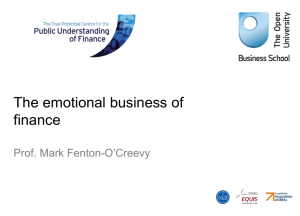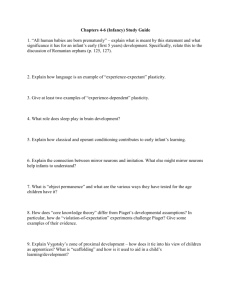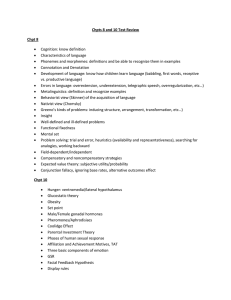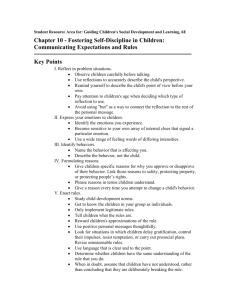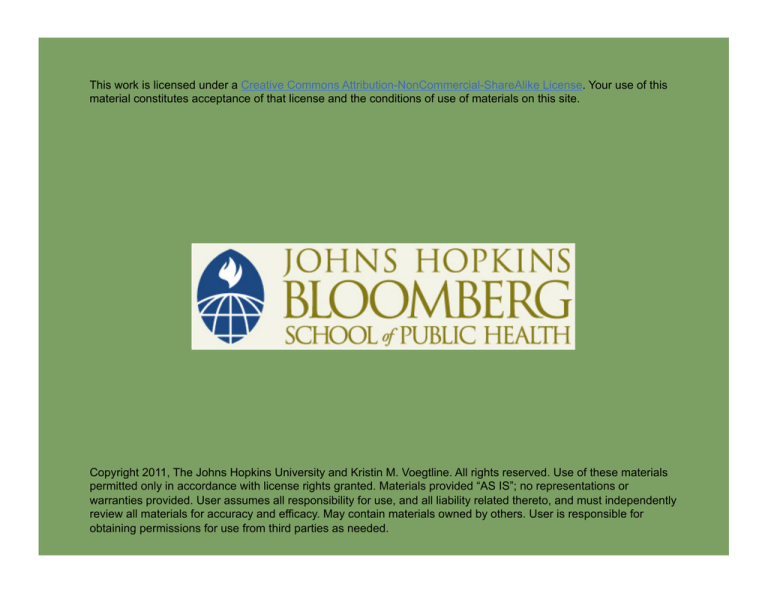
This work is licensed under a Creative Commons Attribution-NonCommercial-ShareAlike License. Your use of this
material constitutes acceptance of that license and the conditions of use of materials on this site.
Copyright 2011, The Johns Hopkins University and Kristin M. Voegtline. All rights reserved. Use of these materials
permitted only in accordance with license rights granted. Materials provided “AS IS”; no representations or
warranties provided. User assumes all responsibility for use, and all liability related thereto, and must independently
review all materials for accuracy and efficacy. May contain materials owned by others. User is responsible for
obtaining permissions for use from third parties as needed.
Section B
Early Emotions and Self-Regulation
Definition of Emotion
Feeling, or state of mind, generated from one’s interaction with
biochemical (internal) and/or environmental (external) factors
- Emotions can have a positive or negative valence
- Involves physiological arousal, expressive behaviors, and, in
some cases, conscious experience
3
Emotions in Infancy and Early Childhood
Basic
Self-conscious
-
Joy (3 months)
-
Empathy (1½–2 years)
-
Sadness (3 months)
-
Jealousy (1½–2 years)
-
Disgust (3 months)
-
-
Embarrassment (1½–2
years)
Anger (2–6 months)
-
Pride (2½ years)
-
Shame (2½ years)
-
Guilt (2½ years)
-
-
Surprise (first 6 months)
Fear (6–8 months)
4
The Function of Early Emotions
Communicate needs
- Solicit external response from a caregiver
- Promotes survival
E.g., hunger cry
Relational
- A way to engage in interactions with others and to understand
others’ emotions
E.g., reflexive smile social smile
Energize development and fuel children’s behavior
5
What Is Emotion Self-Regulation?
Definition: the capacity to control behavioral expression of basic
emotions
- In particular, the expression of negative emotions like anger or
fear
6
Kopp’s Developmental Phases of Self-Regulation
Neurophysiological modulation (birth to 3 months)
Sensorimotor modulation (3 to 9+ months)
Control (12 to 18+ months)
Self-regulation (24+ months)
Source: Kopp. (1982).
7
Neurophysiological Modulation (Birth to 3 Months)
Modulation of arousal
State transitioning (e.g., sleep-wake cycle)
Organized behavior patterns (e.g., thumb or finger sucking)
- Reflection of central nervous system maturity
- Transition from intra- to extrauterine regulation
- Temperamental differences present at birth in reactivity to
sensory stimuli
8
Sensorimotor Modulation (3 to 9+ Months)
Increased volitional regulatory behavior
Parallels achievement of motor milestones
- Reaching, grasping, locomotion
Awareness of contingent behavior
9
Control (12 to 18+ Months)
Emerging ability to show awareness and compliance with social or
task demands
Self-initiated monitoring of behavior
- Physical acts
E.g., walking and exploration
- Communication
E.g., reciprocal interaction
- Emotional signals
E.g., behavioral inhibition
10
Self-Regulation (24+ months)
Increased flexibility in adapting behavior to meet situational
demands
Newfound, but varying, capacity for delay and waiting
Self-awareness develops
- Self vs. other
Gestural communication expands
- Intent, desires, refusals, sharing, etc.
11
How Do We Measure Regulatory Behaviors?
Regulation behaviors
- Attention: orienting, looking to the parent
- Self-soothing: thumb sucking
- Communication: requests, gestures
- Avoidance: turn away
We can observe these behaviors during situations that are
emotionally challenging
- Novel
Stranger approach
- Fear-eliciting
Masks
- Frustration-eliciting
Toy removal, delay of gratification
12





